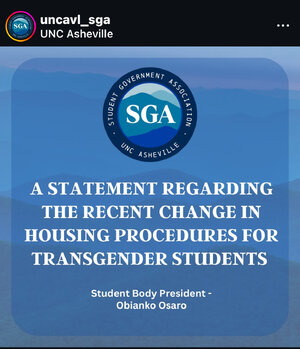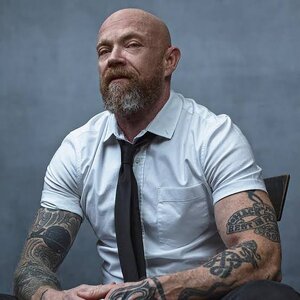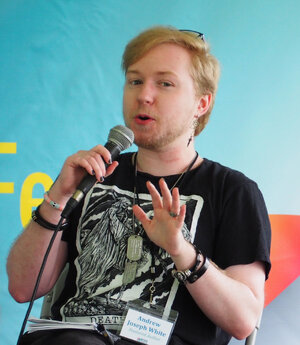EhringhausSouth
Distinguished Member
- Messages
- 271
Just don't share your theory around here. I totally got a ban for sharing something I think it happening. And what I was saying started happening on the thread, and still, ban! Wowzers.
Follow along with the video below to see how to install our site as a web app on your home screen.
Note: This feature may not be available in some browsers.
Foster is worried for other trans students on campus. He’s especially angry because UNCA for years has promoted itself as an inclusive liberal university, he said.“Since me and my suitemates are all in their words, 'in the same situation,' they told me they would just change all of our gender markers to female. I was shocked. I was appalled. I immediately said, 'no. I don’t want that to happen.' They said, 'if you don’t want that to happen, you guys are all going to have to change your records and we’re going to need legal documentation.' I have legal documentation. I had that even before I applied to come here," Foster said.
The June 11, 2025, email you reference was sent to ensure UNC Asheville is compliant with UNC System policy and state and federal law. This was not a “trans (housing) re-assignment initiative” as you describe it, and the email was not targeted to students based on their identity. The email informed directly impacted students of an update to university housing procedures and invited them to meet with University Housing and Residence Life staff to support their residential housing needs. This was not done in response to changes in DEI-related policies.
“I was drawn to this school because it had been advertised as very heavily left-leaning liberal arts school. Over at the library at the quad they used to have these giant banners, three banners. One of them was a pride flag, one was a land acknowledgement, and one I believe was a Black Lives Matter banner. All of those things are now gone.," Foster said. "They just cut a bunch of our liberal arts programs and they’re quickly turning UNCA into the opposite of what they’re still advertising themselves as. I’m concerned for my community here. I don’t know what’s going to happen.”We continuously review our policies and practices to ensure they comply with UNC System policy, laws, and regulations, and that they align with our mission. UNC Asheville has 16 residence halls and approximately 1,600 students who live on campus.

Using this link solely for the gift link:
A provacative piece by Andrew Sullivan … this part certainly expressed something that has been bothering me, especially watching my son and his friends navigate puberty and beyond:
“… To begin with, gays and lesbians, including me, empathized with kids with gender dysphoria, and trusted the medical profession with the rest. If this helped kids or even saved their lives, as was often emphasized, what business was it of mine? If transitioning this young in life helped some pass better as adults, good for them.
Still, questions lingered, drawn from my own life. As a child, uninterested in playing team sports but very interested in the boys who played team sports, I was once asked by a girl when I was just 10 years old, “Are you sure you’re not really a girl?” Of course not, I replied.
But I wonder how I might have responded if someone in authority — a parent or a teacher or a doctor — had suggested that my difference and occasional anxiety was because I was, in fact, a girl. That my body was irrelevant, and that I could choose to be the opposite sex before puberty and all my confusions would disappear. I just don’t know what I would have said or done, to be honest.
And how do today’s parents, teachers and doctors know for sure that a 10-year-old child isn’t, well, like me, and really is trans? How can they know for sure that the gender dysphoria isn’t instead a manifestation of being gay or lesbian and wanting to change it? How do they know for sure there isn’t another complicating personal or psychological factor? I was told not to worry. A child had to demonstrate a “persistent, consistent and insistent” trans identity for years even to be considered for medical intervention.
But this, I found out, was no longer true. The whole point of the new regime of gender-affirming care was that it rejected broad mental health assessments of children that could ensure that mistakes really didn’t happen. The old “persistent, consistent and insistent” model was deemed transphobic and loosened to become an affirmation policy. As soon as a kid said he or she was the opposite sex, further counseling and mental health exploration was deemed problematic, because it amounted to transphobic conversion therapy, we were told. When I said that seemed crazy, and that surely we needed more safeguards, I was sternly told, “Children know who they are.”
… In the Netherlands, the famous Dutch protocol for gender-affirming care was pioneered in the 1990s with far stricter safeguards in place than exist in the United States today. There, of a cohort of 70 adolescents referred to an Amsterdam clinic from 2000 to 2008, 62 were same-sex attracted. And it’s easy to see that one way to “cure” yourself of attraction to the same sex is to become the opposite one. At Britain’s now-shuttered Tavistock clinic, according to the investigative journalist Hannah Barnes, staff members had a dark joke that at the rate they were going, there would be “no gay people left.” This is why sex-change surgeries are permitted and even subsidized in Iran: It’s a way to rid the country of gay people.
And a fix for gender dysphoria for gay and lesbian kids can be puberty itself, as it was for me and many of my gay male friends. Once my own hormones kicked in, my anxieties evaporated. I loved being a boy, I realized. Puberty blockers literally block gay and lesbian kids from the chance at that possible resolution of their gender dysphoria. There is a real conflict here, and it’s obscured by the L.G.B.T.Q.+ identity.…”
I don’t endorse her POV, as noted just piggybacking the gift link.“Only a gay man could get away with saying this”
How sad considering this all seems like common sense.
Using this link solely for the gift link:
A provacative piece by Andrew Sullivan … this part certainly expressed something that has been bothering me, especially watching my son and his friends navigate puberty and beyond:
“… To begin with, gays and lesbians, including me, empathized with kids with gender dysphoria, and trusted the medical profession with the rest. If this helped kids or even saved their lives, as was often emphasized, what business was it of mine? If transitioning this young in life helped some pass better as adults, good for them.
Still, questions lingered, drawn from my own life. As a child, uninterested in playing team sports but very interested in the boys who played team sports, I was once asked by a girl when I was just 10 years old, “Are you sure you’re not really a girl?” Of course not, I replied.
But I wonder how I might have responded if someone in authority — a parent or a teacher or a doctor — had suggested that my difference and occasional anxiety was because I was, in fact, a girl. That my body was irrelevant, and that I could choose to be the opposite sex before puberty and all my confusions would disappear. I just don’t know what I would have said or done, to be honest.
And how do today’s parents, teachers and doctors know for sure that a 10-year-old child isn’t, well, like me, and really is trans? How can they know for sure that the gender dysphoria isn’t instead a manifestation of being gay or lesbian and wanting to change it? How do they know for sure there isn’t another complicating personal or psychological factor? I was told not to worry. A child had to demonstrate a “persistent, consistent and insistent” trans identity for years even to be considered for medical intervention.
But this, I found out, was no longer true. The whole point of the new regime of gender-affirming care was that it rejected broad mental health assessments of children that could ensure that mistakes really didn’t happen. The old “persistent, consistent and insistent” model was deemed transphobic and loosened to become an affirmation policy. As soon as a kid said he or she was the opposite sex, further counseling and mental health exploration was deemed problematic, because it amounted to transphobic conversion therapy, we were told. When I said that seemed crazy, and that surely we needed more safeguards, I was sternly told, “Children know who they are.”
… In the Netherlands, the famous Dutch protocol for gender-affirming care was pioneered in the 1990s with far stricter safeguards in place than exist in the United States today. There, of a cohort of 70 adolescents referred to an Amsterdam clinic from 2000 to 2008, 62 were same-sex attracted. And it’s easy to see that one way to “cure” yourself of attraction to the same sex is to become the opposite one. At Britain’s now-shuttered Tavistock clinic, according to the investigative journalist Hannah Barnes, staff members had a dark joke that at the rate they were going, there would be “no gay people left.” This is why sex-change surgeries are permitted and even subsidized in Iran: It’s a way to rid the country of gay people.
And a fix for gender dysphoria for gay and lesbian kids can be puberty itself, as it was for me and many of my gay male friends. Once my own hormones kicked in, my anxieties evaporated. I loved being a boy, I realized. Puberty blockers literally block gay and lesbian kids from the chance at that possible resolution of their gender dysphoria. There is a real conflict here, and it’s obscured by the L.G.B.T.Q.+ identity.…”
this. everyone is different but it seems to me that sullivan's broader claim that he thinks that a significant # of kids who are actually gay or lesbian are being pushed into being trans is spurious at best and transphobic at worst. maybe it happens occasionally but gender dysphoria is extremely different from same sex attraction.I would never argue that it isn't complicated, but the trans people that I've talked to, yes a small group, haven't talked about same sex attraction the way my gay daughter or other gay people do, they talked about feelings of being in the wrong body. One of them, after transitioning from a boy to a girl, was still attracted to girls.
Ultimately, my belief is that we do what is right for people overall. Maybe that's some regulations to ensure a consistent mental health evaluation and help to guide and set standards, but it isn't a blanket block of potential treatments. That's as narrow minded and one sided as thinking that abortion is only for birth control, when it is clearly an option in many other medical situations.
It’s a very rational position to say that kids that are trans should be given counseling when they are under 18 to help them accept their bodies and their feelings to ensure they grow up healthy physically and mentally. Once they hit adulthood, they are free to do whatever medically they choose to do.this. everyone is different but it seems to me that sullivan's broader claim that he thinks that a significant # of kids who are actually gay or lesbian are being pushed into being trans is spurious at best and transphobic at worst. maybe it happens occasionally but gender dysphoria is extremely different from same sex attraction.
i do agree with his lament on "persistent, consistent and insistent," though. it doesn't make sense to me to have done away with that, kids can be so fickle.
I believe counseling is normal, the go to school a boy come home a girl is more trump bullshit.It’s a very rational position to say that kids that are trans should be given counseling when they are under 18 to help them accept their bodies and their feelings to ensure they grow up healthy physically and mentally. Once they hit adulthood, they are free to do whatever medically they choose to do.
It is important to note that the “wait until they are adults for medical intervention” potion is basically every other country in the world. The US is currently outside the norm.I believe counseling is normal, the go to school a boy come home a girl is more trump bullshit.
But I've read that conversion is more successful if hormone blockers are used to delay puberty. I've also read that if puberty blockers are discontinued the body will basically resume the process.
Ultimately this is a medical and personal decision, we all have opinions, but those opinions are not relevant to these people's lives.
I remember that happening in 1789 also. That worked for a long time.It is important to note that the “wait until they are adults for medical intervention” potion is basically every other country in the world. The US is currently outside the norm.
When did, what other countries do, become our standard?It is important to note that the “wait until they are adults for medical intervention” potion is basically every other country in the world. The US is currently outside the norm.
I think if you are a substantial outlier from other countries (both conservative and liberal countries), you have to look at your position and make sure you are extra comfortable with it because it would be one thing to be at opposite end with a third world country but all of Europe, Asia, etc is something else.When did, what other countries do, become our standard?
I've heard that same argument in regard to GMO crops also, and it's equally as bad.
Some countries sentence people to death for gay sex, are those the ones we should follow?
Europe also approved thalidomide, it's probably good that the US FDA didn't approve for treating morning sickness as other countries did.
I can appreciate your opinion, but I believe there are more important variables in the decision making process than the positions of other countries. I would prefer those other variables be given greater consideration.I think if you are a substantial outlier from other countries (both conservative and liberal countries), you have to look at your position and make sure you are extra comfortable with it because it would be one thing to be at opposite end with a third world country but all of Europe, Asia, etc is something else.
It is the opposite of the dominant position.It is important to note that the “wait until they are adults for medical intervention” potion is basically every other country in the world. The US is currently outside the norm.
He's lying. The outlier position is restricting access, not permitting access.I can appreciate your opinion, but I believe there are more important variables in the decision making process than the positions of other countries. I would prefer those other variables be given greater consideration.
Damn.
"ASHEVILLE, N.C. (WLOS) — Transgender students say University of North Carolina Asheville's new housing policy requirements target trans students, UNCA says that’s false.
News 13 has confirmed an updated UNCA policy that dates back to 2013, that may force transgender students living in dorms to live with suitemates who’s sex they don’t identify with.
News 13 spoke with three students who received notice of an on-campus housing policy change. All report they are transgender. Each said UNCA is requiring documentation of their legal gender that may include their gender at birth.
The UNC Policy Manual on campus housing obtained by News 13 shows it was adopted by the UNC System on August 9, 2013.
The policy reads: “The constituent institutions shall not assign members of the opposite sex to any institutionally owned and operated dormitory room, dormitory suite, or campus apartment unless the students are siblings, parent and child, or they are legally married. This policy applies to housing assignments beginning with the fall 2013 semester.”
On June 11, UNCA’s Housing and Residential Life department sent a six-paragraph email to some students living in dorm rooms.
The email reads in part: “We are reaching out to you today with an update about Housing and Residence Life policy and procedures that will require a change in your housing assignment.” “Please schedule an appointment between June 11 and June 19 to speak with a staff member from Housing and Residence Life.”
“I’m in Aspen Hall on the first floor,” said Ryan Foster, a rising senior at UNCA who identifies as male. “The only separation that occurs is within the rooms themselves.”
Foster said the policy at UNCA says suitemates must be same sex, but dorms are co-ed on all floors. Foster is paying for year-round housing on campus.
Now Foster and other trans students said they’re worried and angered about new DEI policies and this housing change.
“I’ve been consistently identifying as male for longer than I’ve been a student here. The initial email they sent was extremely vague. It kind of sends a lot of people into kind of a panic," Foster said.
Foster said he called UNCA’s housing department and spoke with a staff member.
Foster is worried for other trans students on campus. He’s especially angry because UNCA for years has promoted itself as an inclusive liberal university, he said.
He finds the changing UNCA climate hypocritical and said policy changes have been extreme since the Trump administration took over.
“Right now, we’re just at a point where we’re trying to keep each other safe. All I want to do is exist. All anyone wants to do is exist," Foster said.
UNCA spokesman Brian Hart emailed a statement in response to allegations of the updated policy targeting trans students:
“I was drawn to this school because it had been advertised as very heavily left-leaning liberal arts school. Over at the library at the quad they used to have these giant banners, three banners. One of them was a pride flag, one was a land acknowledgement, and one I believe was a Black Lives Matter banner. All of those things are now gone.," Foster said. "They just cut a bunch of our liberal arts programs and they’re quickly turning UNCA into the opposite of what they’re still advertising themselves as. I’m concerned for my community here. I don’t know what’s going to happen.”

Trans students say UNC Asheville housing policy targets them, university denies claims
Transgender students say University of North Carolina Asheville's new housing policy requirements target trans students, UNCA says that’s false.wlos.com


i'm sure you'd love for your daughter to be rooming with 20-year old versions of these peopleUNC-A, left wing leaning or not perhaps understands the difference in male and female. Absolutely absurd the idea that someone could send their daughter to college and she winds up forced to room with a male that thinks he is a female, or pretending to be a female, or whatever the case may be. Thing 20 years ago that were inconceivable and the plot of a silly south park episode are becoming reality.


